Metalworking Fluids Market
Metalworking Fluids Market Size and Share Forecast Outlook 2025 to 2035
Metalworking fluids market is projected to grow from USD 12.8 billion in 2025 to USD 16.5 billion by 2035, at a CAGR of 2.6%. Water-soluble fluids will dominate with a 47.0% market share, while automotive will lead the end use segment with a 41.0% share.
Metalworking Fluids Market Forecast and Outlook 2025 to 2035
The global metalworking fluids market is valued at USD 12.8 billion in 2025. It is slated to reach USD 16.5 billion by 2035, recording an absolute increase of USD 3.7 billion over the forecast period. This translates into a total growth of 28.9%, with the market forecast to expand at a compound annual growth rate (CAGR) of 2.6% between 2025 and 2035.
The overall market size is expected to grow by nearly 1.29X during the same period, supported by increasing manufacturing activities, growing automotive production, and rising demand for precision machining applications across diverse metalworking, manufacturing, and industrial processing sectors.
Quick Stats for Metalworking Fluids Market
- Metalworking Fluids Market Value (2025): USD 12.8 billion
- Metalworking Fluids Market Forecast Value (2035): USD 16.5 billion
- Metalworking Fluids Market Forecast CAGR: 2.6%
- Leading Type in Metalworking Fluids Market: Water-soluble fluids
- Key Growth Regions in Metalworking Fluids Market: Asia Pacific, North America, and Europe
- Key Players in Metalworking Fluids Market: Quaker Houghton, Fuchs, ExxonMobil, Castrol, TotalEnergies, Chevron
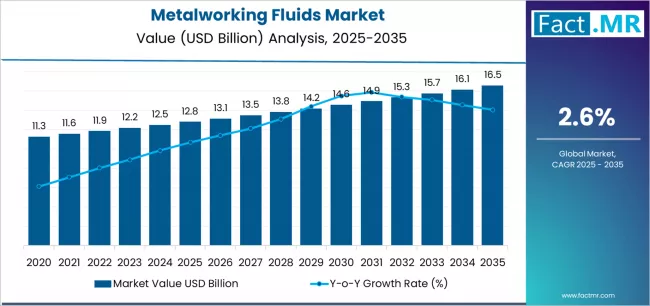
Between 2025 and 2030, the metalworking fluids market is projected to expand from USD 12.8 billion to USD 14.5 billion, resulting in a value increase of USD 1.7 billion, which represents 45.9% of the total forecast growth for the decade. This phase of development will be shaped by increasing industrial manufacturing activities, rising precision machining requirements, and growing adoption of advanced metalworking technologies. Manufacturing companies and machining service providers are expanding their metalworking fluid utilization capabilities to address the growing demand for efficient and reliable machining solutions that ensure operational performance and cost optimization.
Metalworking Fluids Market Key Takeaways
| Metric | Value |
|---|---|
| Estimated Value in (2025E) | USD 12.8 billion |
| Forecast Value in (2035F) | USD 16.5 billion |
| Forecast CAGR (2025 to 2035) | 2.6% |
The automotive manufacturing market is one of the largest contributors, accounting for around 30-35%. Metalworking fluids are essential in automotive production for cutting, cooling, and lubrication processes during the manufacturing of engine parts, chassis, and other critical components. The machinery and equipment manufacturing market holds about 20-25%, as metalworking fluids are crucial for precision machining and fabrication processes in the production of complex machinery components and industrial equipment.
The metal processing market contributes approximately 15-20%, where metalworking fluids play a vital role in processes like grinding, drilling, and turning, enhancing the efficiency and quality of operations in industries such as steel, aluminum, and other metal production. The aerospace manufacturing market accounts for around 10-15%, as the need for high-performance metalworking fluids is critical in the production of lightweight and durable aerospace components, ensuring high precision and superior finish. The electronics manufacturing market represents about 5-10%, where metalworking fluids are used for cutting and shaping components for devices like smartphones, computers, and other electronic products.
Why is the Metalworking Fluids Market Growing?
Market expansion is being supported by the increasing global manufacturing activities driven by industrial automation and precision manufacturing requirements, alongside the corresponding need for effective lubrication solutions that can enhance machining performance, support tool longevity, and maintain operational efficiency across various metalworking, automotive manufacturing, and industrial processing applications. Modern manufacturing companies are increasingly focused on implementing metalworking fluid solutions that can provide machining optimization, support cost reduction, and ensure environmental compliance while meeting comprehensive performance and regulatory requirements.
The growing emphasis on manufacturing efficiency and precision machining is driving demand for metalworking fluids that can support advanced manufacturing processes, enable high-precision applications, and ensure comprehensive quality control. Industrial manufacturers' preference for fluids that combine lubrication effectiveness with cooling performance and environmental responsibility is creating opportunities for innovative metalworking fluid implementations. The rising influence of electric vehicle production and renewable energy manufacturing is also contributing to increased adoption of metalworking fluid solutions that can provide performance benefits without compromising environmental objectives or operational efficiency.
Segmental Analysis
The market is segmented by type, application, and end use. By type, the market is divided into water-soluble fluids, neat oils, and semi-synthetics & synthetics. Based on application, the market is categorized into cutting & grinding, forming, and protectives & others. By end use, the market includes automotive, general engineering, and aerospace & others. Regionally, the market is divided by North America, Europe, Asia Pacific, Latin America, and Middle East & Africa.
By Type, the Water-Soluble Fluids Segment Leads the Market
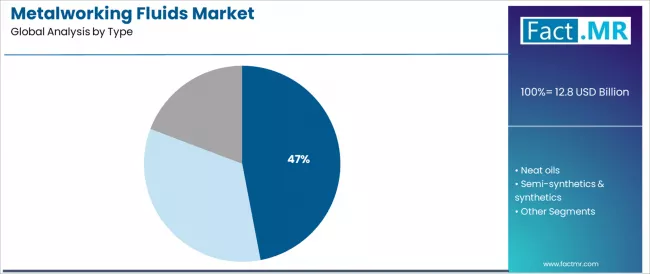
The water-soluble fluids segment is projected to maintain its leading position in the metalworking fluids market in 2025 with a 47.0% market share, reaffirming its role as the preferred fluid category for cooling-intensive applications and cost-effective machining operations. Manufacturing companies increasingly utilize water-soluble metalworking fluids for their superior cooling characteristics, proven cost-effectiveness, and established effectiveness in providing efficient heat removal while supporting diverse machining operations and environmental compliance requirements. Water-soluble fluid technology's proven performance and widespread applicability directly address the industry requirements for effective cooling solutions and comprehensive machining support across diverse industrial sectors and processing conditions.
This type segment forms the foundation of modern machining operations, as it represents the fluid category with the greatest contribution to heat management and established commercial acceptance across multiple manufacturing processes and global markets. Industrial investments in efficient machining technologies continue to strengthen adoption among manufacturers and machining service providers. With growing demands for cost-effective cooling solutions and environmental compliance, water-soluble fluids align with both performance requirements and economic objectives, making them the central component of comprehensive metalworking fluid strategies.
By End Use, the Automotive Segment Dominates Market Demand
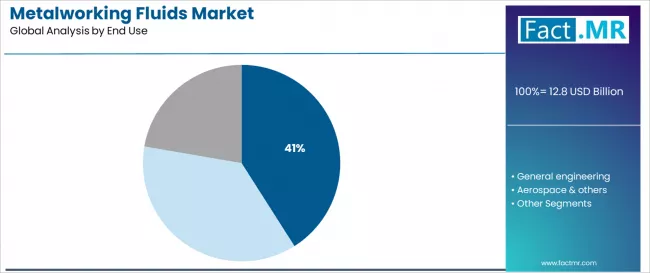
The automotive end use segment is projected to represent the largest share of metalworking fluids demand in 2025 with a 41.0% market share, underscoring its critical role as the primary driver for fluid adoption across vehicle manufacturing, component machining, and automotive assembly operations. Automotive manufacturers prefer metalworking fluids for their proven machining enhancement capabilities, established tool life benefits, and ability to support production efficiency while maintaining quality standards and cost-effectiveness. Positioned as essential materials for modern automotive manufacturing, metalworking fluids offer both operational advantages and quality assurance benefits.
The segment is supported by continuous innovation in automotive manufacturing and the growing availability of specialized fluid formulations that enable superior machining performance with enhanced tool protection and environmental compliance. Automotive manufacturers are investing in comprehensive machining optimization programs to support increasingly complex component requirements and production efficiency objectives. As automotive technology advances and manufacturing precision increases, the automotive segment will continue to dominate the market while supporting advanced metalworking fluid utilization and manufacturing optimization strategies.
What are the Drivers, Restraints, and Key Trends of the Metalworking Fluids Market?
The metalworking fluids market is advancing steadily due to increasing demand for manufacturing efficiency driven by industrial automation and growing adoption of precision machining technologies that require effective lubrication solutions providing machining enhancement, tool protection, and operational optimization across diverse automotive, aerospace, general engineering, and industrial manufacturing applications. The market faces challenges, including environmental regulations and disposal complexity, health and safety concerns related to fluid exposure, and cost pressures from alternative processing methods and dry machining technologies. Innovation in bio-based formulations and sustainable fluid technologies continues to influence product development and market expansion patterns.
Expansion of Electric Vehicle Manufacturing and Advanced Materials Processing
The growing adoption of electric vehicles is driving demand for metalworking fluids that address specialized machining requirements for electric motor components, battery housing manufacturing, and advanced materials processing while maintaining environmental compliance and operational efficiency. Electric vehicle manufacturers require fluid solutions with enhanced compatibility for new materials, proven electrical safety characteristics, and specialized cooling capabilities that enable innovative manufacturing processes. Automotive companies are increasingly recognizing the competitive advantages of advanced metalworking fluid integration for electric vehicle component production and manufacturing optimization, creating opportunities for specialized formulations designed for next-generation automotive applications and sustainable mobility manufacturing.
Integration of Bio-Based Formulations and Sustainable Manufacturing Practices
Modern metalworking fluid producers are incorporating renewable feedstocks and biodegradable formulations to enhance environmental performance, reduce regulatory compliance complexity, and support comprehensive sustainability through optimized chemistry platforms and renewable raw material utilization. Leading companies are developing plant-based fluid systems, implementing biodegradable additive technologies, and advancing formulations that provide effective machining performance while minimizing environmental impact and disposal requirements. These technologies improve environmental credentials while enabling new market opportunities, including sustainable manufacturing applications, environmentally conscious machining operations, and green manufacturing initiatives. Advanced sustainability integration also allows producers to support comprehensive environmental compliance objectives and market differentiation beyond traditional performance and cost considerations.
Development of Smart Manufacturing Integration and Performance Monitoring
The expansion of Industry 4.0 technologies and smart manufacturing systems is driving demand for metalworking fluids with integrated monitoring capabilities, predictive maintenance compatibility, and performance optimization features that exceed traditional lubrication and cooling applications. These advanced applications require specialized fluid formulations with sensor compatibility and data integration capabilities that support intelligent manufacturing systems, creating premium market segments with differentiated value propositions. Manufacturers are investing in smart fluid technologies and IoT integration capabilities to serve emerging automated manufacturing applications while supporting innovation in intelligent machining systems and predictive maintenance programs.
Analysis of the Metalworking Fluids Market by Key Countries
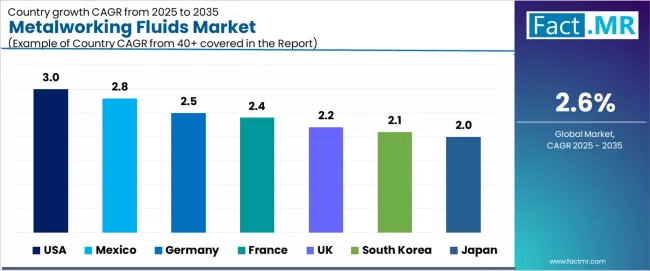
| Country | CAGR (2025-2035) |
|---|---|
| USA | 3.0% |
| Mexico | 2.8% |
| Germany | 2.5% |
| France | 2.4% |
| UK | 2.2% |
| South Korea | 2.1% |
| Japan | 2.0% |
The metalworking fluids market is experiencing moderate growth globally, with the USA leading at a 3.0% CAGR through 2035, driven by expanding manufacturing activities, comprehensive automotive production, and increasing adoption of precision machining technologies supported by advanced industrial infrastructure and manufacturing modernization programs. Mexico follows at 2.8%, supported by rapid automotive manufacturing expansion, growing industrial development, and increasing investment in advanced manufacturing capabilities. Germany shows growth at 2.5%, emphasizing automotive engineering excellence, precision manufacturing leadership, and advanced machining technology development. France demonstrates 2.4% growth, supported by automotive industry strength, aerospace manufacturing capabilities, and comprehensive industrial modernization programs. The UK records 2.2%, focusing on manufacturing efficiency improvement, aerospace applications, and advanced machining technology adoption. South Korea exhibits 2.1% growth, emphasizing automotive production, shipbuilding applications, and industrial manufacturing excellence. Japan shows 2.0% growth, supported by precision manufacturing leadership, automotive technology excellence, and advanced machining system development.
The report covers an in-depth analysis of 40+ countries, with top-performing countries are highlighted below.
USA Leads Global Market Growth with Manufacturing Modernization and Automotive Excellence
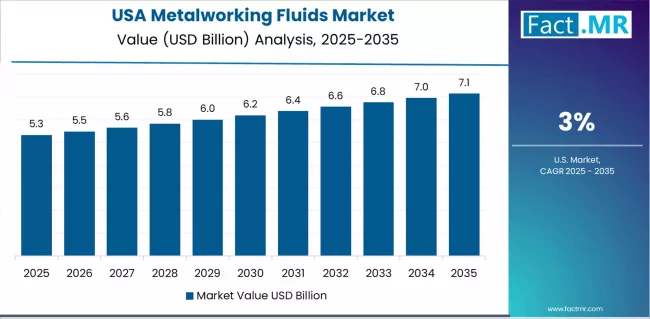
Revenue from metalworking fluids in the USA is projected to exhibit exceptional growth with a CAGR of 3.0% through 2035, driven by expanding manufacturing activities and comprehensive automotive production capabilities supported by industrial modernization programs and increasing focus on precision manufacturing technologies. The country's robust industrial base and advanced machining capabilities are creating substantial demand for effective metalworking fluid solutions. Major manufacturing companies and machining service providers are establishing comprehensive fluid management capabilities to serve both domestic production needs and export opportunities.
- Growing manufacturing modernization and industrial automation are driving demand for metalworking fluids throughout major industrial centers and manufacturing facilities across automotive, aerospace, and general engineering applications nationwide.
- Strong automotive manufacturing and production capabilities are supporting fluid adoption among manufacturers seeking machining optimization and tool life enhancement for diverse vehicle component production and assembly operations.
- Advanced precision machining and manufacturing technology development are creating opportunities for specialized fluid applications throughout major machining centers and high-precision manufacturing facilities emphasizing quality and efficiency optimization.
- Expanding aerospace manufacturing and defense production programs are driving demand for high-performance fluid solutions supporting critical component machining and precision manufacturing applications across major aerospace manufacturing centers.
Mexico Demonstrates Strong Market Potential with Automotive Manufacturing and Industrial Development
Demand for metalworking fluids in Mexico is anticipated to expand at a CAGR of 2.8%, supported by rapid automotive manufacturing expansion, growing industrial development capabilities, and increasing investment in advanced manufacturing technologies supporting fluid integration across diverse automotive and manufacturing applications. The country's expanding automotive production base and industrial modernization are driving sophisticated fluid utilization throughout manufacturing and machining sectors. Leading multinational companies and domestic manufacturers are establishing extensive fluid management and application capabilities.
- Rapid automotive manufacturing growth and expanding production capabilities are creating opportunities for metalworking fluid adoption throughout major automotive centers and supplier networks serving domestic and export markets including USMCA trade benefits.
- Growing industrial development and manufacturing capacity expansion are driving fluid adoption among manufacturers seeking machining efficiency and operational optimization in competitive manufacturing environments.
- Strategic geographic advantages and trade relationship benefits are supporting fluid market development including efficient supply chains, competitive operational costs, and optimized access to North American manufacturing expertise and technologies.
- Expanding workforce development and technical education programs are enabling advanced fluid management technologies and specialized machining expertise throughout major manufacturing regions and industrial centers.
Germany Emphasizes Manufacturing Excellence with Automotive Innovation and Precision Machining Leadership
Revenue from metalworking fluids in Germany is projected to grow at a CAGR of 2.5%, supported by the country's manufacturing excellence, established automotive industry leadership, and comprehensive precision machining capabilities supporting high-quality fluid applications. Germany's engineering expertise and manufacturing focus are supporting investment in sophisticated metalworking fluid solutions. Major automotive manufacturers and precision machining companies are establishing comprehensive development and application capabilities for advanced fluid systems.
- Advanced manufacturing excellence and automotive industry leadership are creating demand for high-performance metalworking fluids throughout major automotive centers and precision manufacturing facilities emphasizing quality optimization and engineering excellence.
- Strong precision machining capabilities and advanced manufacturing technologies are driving the development of specialized fluid applications including high-precision machining, advanced materials processing, and efficiency optimization throughout major manufacturing operations.
- Comprehensive automotive engineering requirements and quality standards are advancing fluid applications including component machining, assembly operations, and manufacturing optimization throughout major automotive production facilities and supplier networks.
- Export market leadership and international manufacturing reputation are enabling German fluid solutions to access global markets while maintaining premium positioning and technology advancement advantages.
France Shows Industrial Strength with Automotive Excellence and Aerospace Applications
Demand for metalworking fluids in France is expanding at a CAGR of 2.4%, driven by industrial manufacturing capabilities, established automotive industry strength, and comprehensive aerospace manufacturing programs supporting fluid development in automotive and industrial applications. The country's industrial heritage and technology focus are creating opportunities for sophisticated fluid utilization. Leading automotive companies and aerospace manufacturers are establishing comprehensive machining optimization programs incorporating performance enhancement and operational efficiency.
- Strong automotive industry and manufacturing capabilities are creating demand for advanced metalworking fluids throughout major automotive centers and manufacturing facilities supporting component production and assembly operations.
- Established aerospace manufacturing excellence and defense industry capabilities are supporting fluid integration including precision machining, advanced materials processing, and high-performance applications throughout major aerospace manufacturing centers.
- Comprehensive industrial manufacturing and technology development are advancing fluid applications including machining optimization, tool life enhancement, and operational efficiency improvement throughout major manufacturing facilities and machining centers.
- Premium manufacturing culture and quality excellence expectations are driving demand for superior fluid solutions supporting luxury automotive applications and high-performance aerospace component manufacturing throughout major industrial regions.
UK Demonstrates Manufacturing Innovation with Aerospace Applications and Technology Development
Revenue from metalworking fluids in the UK is growing at a CAGR of 2.2%, supported by comprehensive manufacturing innovation programs, established aerospace industry capabilities, and advanced machining technology development emphasizing fluid integration for performance enhancement and operational optimization. The country's manufacturing heritage and innovation culture are driving fluid adoption throughout automotive and aerospace sectors. Leading manufacturing companies and aerospace contractors are establishing advanced machining and fluid management capabilities.
- Comprehensive manufacturing innovation and technology development are creating systematic market opportunities for metalworking fluids throughout major manufacturing centers and machining facilities emphasizing efficiency improvement and quality optimization.
- Strong aerospace industry capabilities and advanced manufacturing applications are supporting fluid development including precision machining, critical component production, and high-performance applications throughout major aerospace manufacturing operations.
- Advanced machining technologies and automation integration are enabling fluid application optimization including performance enhancement, tool life improvement, and operational efficiency throughout major manufacturing facilities and precision machining centers.
- Innovation in manufacturing technology and machining science is supporting fluid utilization enhancement including performance monitoring, application optimization, and sustainability integration throughout modern manufacturing operations.
South Korea Emphasizes Industrial Excellence with Automotive Production and Shipbuilding Applications
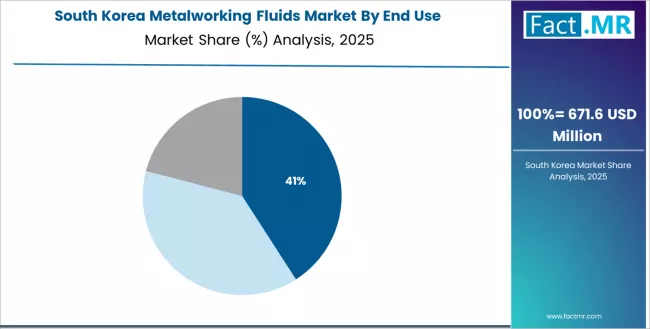
Demand for metalworking fluids in South Korea is forecasted to expand at a CAGR of 2.1%, supported by comprehensive industrial manufacturing excellence, automotive production capabilities, and shipbuilding industry strength emphasizing fluid integration for manufacturing optimization and industrial development. The country's manufacturing excellence and technology focus are driving sophisticated fluid utilization in automotive and industrial applications. Leading manufacturing companies and industrial producers are establishing advanced fluid management and application capabilities.
- Comprehensive automotive production and manufacturing excellence are creating demand for metalworking fluid solutions throughout major automotive centers and manufacturing facilities emphasizing production efficiency and quality optimization.
- Advanced shipbuilding capabilities and heavy industry manufacturing are supporting fluid integration in diverse applications including marine component production, industrial equipment machining, and specialized manufacturing applications.
- Technology integration focus and manufacturing innovation are advancing fluid applications including machining optimization, operational efficiency, and automation integration throughout major industrial facilities and manufacturing centers.
- Export manufacturing capabilities and international market presence are enabling South Korean fluid applications to serve global markets while maintaining quality standards and competitive positioning advantages.
Japan Shows Manufacturing Precision with Automotive Excellence and Advanced Machining Technologies
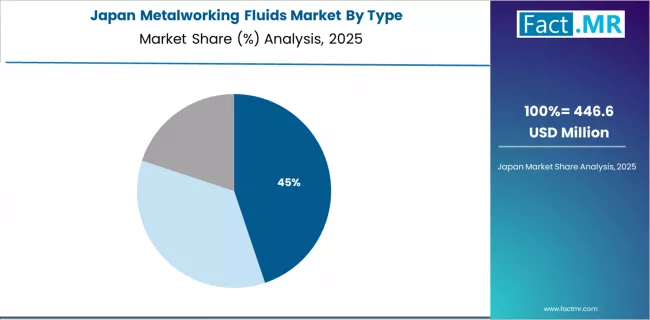
Revenue from metalworking fluids in Japan is projected to grow at a CAGR of 2.0%, driven by exceptional manufacturing precision standards, established automotive industry excellence, and comprehensive advanced machining technology development emphasizing superior fluid performance and operational optimization. The country's commitment to manufacturing excellence and precision engineering are creating opportunities for ultra-high-performance fluid applications. Leading automotive manufacturers and precision machining companies are establishing comprehensive quality control and innovation programs.
- Exceptional automotive manufacturing standards and precision engineering capabilities are creating demand for ultra-high-quality metalworking fluids meeting Japanese automotive industry requirements for machining consistency and operational reliability.
- Advanced machining technology and precision manufacturing excellence are supporting fluid optimization including performance enhancement, tool life extension, and quality improvement throughout major automotive manufacturing facilities and precision machining centers.
- Comprehensive quality control systems and rigorous manufacturing standards are ensuring superior fluid consistency and performance throughout major automotive manufacturing regions and precision industrial applications.
- Manufacturing innovation culture and continuous improvement focus are driving demand for fluid solutions that combine performance excellence with environmental responsibility and sustainable manufacturing practices.
Europe Market Split by Countries
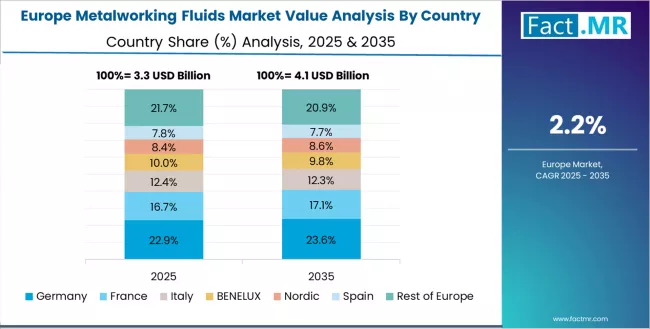
The metalworking fluids market in Europe is projected to grow from USD 3.84 billion in 2025 to USD 4.95 billion by 2035, registering a CAGR of 2.6% over the forecast period. Germany is expected to maintain leadership with a 29.0% market share in 2025, moderating to 28.7% by 2035, supported by automotive industry excellence, precision manufacturing capabilities, and advanced machining technology development.
France follows with 17.5% in 2025, projected at 17.7% by 2035, driven by automotive industry strength, aerospace manufacturing capabilities, and industrial modernization programs. The United Kingdom holds 15.0% in 2025, expected to reach 15.2% by 2035 on the back of manufacturing innovation and aerospace applications. Italy commands 12.5% in 2025, rising slightly to 12.6% by 2035, while Spain accounts for 11.0% in 2025, reaching 11.2% by 2035 aided by automotive development and manufacturing growth. The Netherlands maintains 5.5% in 2025, up to 5.6% by 2035 due to advanced manufacturing capabilities and industrial technology focus. The Rest of Europe region, including Nordic countries, Central & Eastern Europe, and other markets, is anticipated to hold 9.5% in 2025 and 9.0% by 2035, reflecting steady growth in manufacturing modernization and industrial development.
Competitive Landscape of the Metalworking Fluids Market
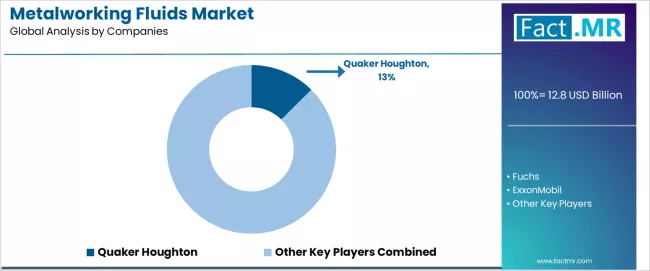
The metalworking fluids market is characterized by competition among established lubricant manufacturers, specialty chemical companies, and integrated fluid solution providers. Companies are investing in formulation technology development, sustainability initiatives, application-specific solution development, and service capability enhancement to deliver high-performance, environmentally responsible, and cost-effective metalworking fluid solutions. Innovation in bio-based formulations, performance enhancement technologies, and integrated service offerings is central to strengthening market position and competitive advantage.
Quaker Houghton leads the market with a 12.5% share, offering comprehensive metalworking fluid solutions with a focus on automotive applications, manufacturing excellence, and technical service integration across diverse machining, forming, and protective coating applications. The company has announced major research and development investments and service capability expansions, with plans to incorporate bio-based formulations and digital service technologies, with program initiatives launched in 2024 and enhanced capabilities planned for 2026. Fuchs provides innovative lubricant solutions with emphasis on performance optimization, having advanced their metalworking fluid strategy by expanding specialty formulations and developing integrated service offerings for automotive and industrial applications.
ExxonMobil delivers comprehensive lubricant solutions including metalworking fluids with focus on performance reliability and global support capabilities. Castrol offers advanced lubricant solutions with emphasis on automotive and industrial applications. TotalEnergies provides comprehensive fluid solutions with focus on European markets and sustainability initiatives. Chevron delivers lubricant solutions and technical support for diverse industrial applications. Idemitsu Kosan focuses on specialty lubricants and high-performance applications. Shell offers global lubricant solutions and technical expertise. Lubrizol provides additive technologies and specialized formulations. Yushiro Chemical specializes in metalworking fluid development and application support.
Metalworking Fluids Market - Stakeholder Contribution Framework
Metalworking fluids represent an essential industrial segment within manufacturing and machining applications, projected to grow from USD 12.8 billion in 2025 to USD 16.5 billion by 2035 at a 2.6% CAGR. These specialized lubricant and coolant systems—primarily water-soluble fluids, neat oils, and synthetic formulations—serve as critical manufacturing enablers in cutting and grinding operations, forming processes, and protective applications where machining efficiency, tool longevity, and operational optimization are essential. Market expansion is driven by increasing manufacturing activities, growing automotive production, expanding precision machining requirements, and rising demand for efficient and sustainable manufacturing solutions across diverse industrial sectors.
How Manufacturing Industry Regulators Could Strengthen Safety Standards and Environmental Compliance
- Health and Safety Standards for Fluid Exposure: Establish comprehensive workplace safety guidelines for metalworking fluid handling including exposure limits, protective equipment requirements, and health monitoring protocols that ensure worker safety while enabling effective manufacturing operations and regulatory compliance across diverse industrial environments.
- Environmental Regulations and Disposal Requirements: Develop stringent environmental standards for metalworking fluid disposal including waste treatment requirements, recycling protocols, and environmental impact minimization that protect environmental resources while supporting sustainable manufacturing practices and regulatory compliance.
- Quality Standards and Performance Requirements: Create comprehensive technical specifications for metalworking fluids including performance criteria, safety requirements, and environmental standards that ensure consistent quality while enabling innovation and cost-effective manufacturing solutions across diverse machining applications.
- Chemical Registration and Safety Assessment: Implement systematic chemical evaluation procedures for metalworking fluid ingredients including toxicological assessment, environmental impact evaluation, and safety data requirements that ensure product safety while facilitating market access and innovation development.
- International Harmonization and Trade Facilitation: Facilitate global regulatory alignment for metalworking fluids including mutual recognition agreements, testing methodology standardization, and trade barrier reduction that support international commerce while maintaining high safety and environmental standards.
How Manufacturing Industry Associations Could Advance Best Practices and Technology Development
- Technical Education and Professional Training: Develop comprehensive education programs for manufacturing professionals covering metalworking fluid selection, application techniques, and safety management that enhance industry expertise while ensuring successful machining operations and workplace safety.
- Best Practice Guidelines and Technical Resources: Create detailed technical resources for metalworking fluid applications including selection criteria, application procedures, and troubleshooting techniques that optimize machining performance while maintaining safety standards and cost effectiveness.
- Research and Development Collaboration: Facilitate partnerships between fluid suppliers, manufacturing companies, research institutions, and equipment manufacturers to advance fluid technologies while accelerating innovation development and machining optimization.
- Environmental Stewardship and Sustainability Promotion: Promote environmentally responsible fluid management including recycling programs, waste reduction initiatives, and sustainable formulation development that address environmental concerns while maintaining manufacturing efficiency and cost competitiveness.
- Quality Certification and Professional Development: Establish industry-wide certification programs and training standards including technical competency requirements, safety protocols, and performance optimization that ensure professional excellence while supporting market confidence and operational success.
How Metalworking Fluid Manufacturers Could Drive Innovation and Market Leadership
- Advanced Formulation Technology and Performance Enhancement: Invest in cutting-edge chemistry research, additive development, and performance optimization that improve machining effectiveness while reducing environmental impact and operational costs for competitive market positioning and customer value creation.
- Sustainable Product Development and Bio-Based Solutions: Develop comprehensive bio-based fluid portfolios including renewable feedstock utilization, biodegradable formulations, and circular economy integration that address environmental requirements while maintaining performance excellence and cost competitiveness.
- Integrated Service Solutions and Technical Support: Establish comprehensive service capabilities including fluid management programs, performance monitoring, technical consultation, and training services that strengthen customer relationships while optimizing machining operations and cost efficiency.
- Digital Integration and Smart Manufacturing Support: Create digital platform capabilities including performance monitoring, predictive maintenance integration, and data analytics services that support Industry 4.0 manufacturing while enhancing operational efficiency and customer value.
- Global Operations and Supply Chain Excellence: Develop efficient global networks including strategic production facilities, supply chain optimization, and customer service capabilities that ensure reliable product availability while minimizing costs and supporting customer requirements worldwide.
How Manufacturing Companies Could Optimize Metalworking Fluid Integration and Performance
- Strategic Fluid Selection and Performance Optimization: Develop comprehensive evaluation criteria for metalworking fluids including performance specifications, cost-benefit analysis, environmental impact assessment, and supplier capabilities that ensure optimal fluid selection while supporting manufacturing efficiency and operational excellence.
- Fluid Management and Operational Excellence: Implement systematic fluid management programs including inventory optimization, performance monitoring, and maintenance scheduling that maximize fluid effectiveness while maintaining cost control and operational efficiency throughout manufacturing operations.
- Environmental Compliance and Sustainability Integration: Incorporate environmental considerations into fluid management including waste minimization, recycling optimization, and sustainable procurement that support environmental objectives while maintaining manufacturing performance and cost competitiveness.
- Training and Safety Management: Establish comprehensive training programs and safety protocols for fluid handling including worker education, exposure prevention, and emergency response that ensure workplace safety while maintaining operational efficiency and regulatory compliance.
- Innovation and Competitive Advantage: Explore advanced fluid technologies and machining optimization including smart manufacturing integration, performance enhancement, and cost reduction that provide competitive advantages while addressing operational challenges and market opportunities.
How Research Institutions Could Advance Fluid Science and Manufacturing Technology
- Fundamental Chemistry Research and Formulation Science: Conduct comprehensive studies investigating metalworking fluid chemistry, tribological mechanisms, and performance optimization that advance scientific understanding while informing technology development and application improvement across diverse manufacturing environments.
- Manufacturing Process Research and Optimization: Study fluid behavior in complex machining systems including cutting dynamics, heat transfer mechanisms, and tool interaction that enable optimized manufacturing processes while addressing technical challenges and performance limitations.
- Environmental Impact and Sustainability Research: Investigate environmental effects of metalworking fluids including biodegradation pathways, toxicological assessment, and lifecycle analysis that support sustainable industry development and environmental stewardship.
- Advanced Materials and Application Development: Develop novel fluid formulations and additive technologies including bio-based systems, performance enhancers, and specialized applications that advance manufacturing capabilities while addressing emerging market requirements.
- Technology Transfer and Industry Collaboration: Facilitate innovation development through industry partnerships, licensing programs, and collaborative research initiatives that accelerate technology adoption while strengthening industry-academia cooperation and commercial application development.
How Investment Community Could Support Market Growth and Innovation Excellence
- Research and Development Investment: Provide capital for breakthrough fluid technologies, sustainable formulation development, and performance enhancement systems that advance industry capabilities while creating competitive advantages and environmental benefits for long-term market success.
- Manufacturing Infrastructure and Capacity Development: Finance production facility development, blending equipment acquisition, and distribution network expansion that address growing market demand while improving operational efficiency and service capabilities.
- Sustainability and Environmental Technology: Support development of bio-based formulations, recycling technologies, and environmental compliance systems that address regulatory requirements while creating market differentiation and competitive advantages.
- Market Development and Geographic Expansion: Fund market entry initiatives, customer acquisition programs, and service capability development that increase market penetration while maintaining quality standards and operational excellence throughout growth phases.
- Strategic Partnership and Technology Acquisition: Provide capital for strategic alliances, technology acquisitions, and collaborative development programs that strengthen market position while enabling access to advanced capabilities, markets, and technologies for comprehensive business development.
Key Players in the Metalworking Fluids Market
- Quaker Houghton
- Fuchs
- ExxonMobil
- Castrol
- TotalEnergies
- Chevron
- Idemitsu Kosan
- Shell
- Lubrizol
- Yushiro Chemical
Scope of the Report
| Items | Values |
|---|---|
| Quantitative Units (2025) | USD 12.8 billion |
| Type | Water-soluble fluids, Neat oils, Semi-synthetics & synthetics |
| Application | Cutting & grinding, Forming, Protectives & others |
| End Use | Automotive, General engineering, Aerospace & others |
| Regions Covered | North America, Europe, Asia Pacific, Latin America, Middle East & Africa |
| Countries Covered | USA, Mexico, Germany, France, UK, South Korea, Japan, and 40+ countries |
| Key Companies Profiled | Quaker Houghton, Fuchs, ExxonMobil, Castrol, TotalEnergies, Chevron |
| Additional Attributes | Dollar sales by type and application category, regional demand trends, competitive landscape, technological advancements in fluid formulations, manufacturing efficiency enhancement, automotive applications, and industrial performance optimization |
Metalworking Fluids Market by Segments
-
Type :
- Water-soluble fluids
- Neat oils
- Semi-synthetics & synthetics
-
Application :
- Cutting & grinding
- Forming
- Protectives & others
-
End Use :
- Automotive
- General engineering
- Aerospace & others
-
Region :
-
North America
- United States
- Canada
- Mexico
-
Europe
- Germany
- United Kingdom
- France
- Italy
- Spain
- Netherlands
- Nordic
- Rest of Europe
-
Asia Pacific
- Japan
- South Korea
- China
- India
- Australia
- Rest of Asia Pacific
-
Latin America
- Brazil
- Argentina
- Rest of Latin America
-
Middle East & Africa
- Kingdom of Saudi Arabia
- Other GCC Countries
- South Africa
- Rest of Middle East & Africa
-
Table of Content
- Executive Summary
- Global Market Outlook
- Demand to side Trends
- Supply to side Trends
- Technology Roadmap Analysis
- Analysis and Recommendations
- Market Overview
- Market Coverage / Taxonomy
- Market Definition / Scope / Limitations
- Market Background
- Market Dynamics
- Drivers
- Restraints
- Opportunity
- Trends
- Scenario Forecast
- Demand in Optimistic Scenario
- Demand in Likely Scenario
- Demand in Conservative Scenario
- Opportunity Map Analysis
- Product Life Cycle Analysis
- Supply Chain Analysis
- Investment Feasibility Matrix
- Value Chain Analysis
- PESTLE and Porter’s Analysis
- Regulatory Landscape
- Regional Parent Market Outlook
- Production and Consumption Statistics
- Import and Export Statistics
- Market Dynamics
- Global Market Analysis 2020 to 2024 and Forecast, 2025 to 2035
- Historical Market Size Value (USD Million) Analysis, 2020 to 2024
- Current and Future Market Size Value (USD Million) Projections, 2025 to 2035
- Y to o to Y Growth Trend Analysis
- Absolute $ Opportunity Analysis
- Global Market Pricing Analysis 2020 to 2024 and Forecast 2025 to 2035
- Global Market Analysis 2020 to 2024 and Forecast 2025 to 2035, By Type
- Introduction / Key Findings
- Historical Market Size Value (USD Million) Analysis By Type , 2020 to 2024
- Current and Future Market Size Value (USD Million) Analysis and Forecast By Type , 2025 to 2035
- Water-soluble fluids
- Neat oils
- Semi-synthetics & synthetics
- Y to o to Y Growth Trend Analysis By Type , 2020 to 2024
- Absolute $ Opportunity Analysis By Type , 2025 to 2035
- Global Market Analysis 2020 to 2024 and Forecast 2025 to 2035, By End Use
- Introduction / Key Findings
- Historical Market Size Value (USD Million) Analysis By End Use, 2020 to 2024
- Current and Future Market Size Value (USD Million) Analysis and Forecast By End Use, 2025 to 2035
- Automotive
- General engineering
- Aerospace & others
- Y to o to Y Growth Trend Analysis By End Use, 2020 to 2024
- Absolute $ Opportunity Analysis By End Use, 2025 to 2035
- Global Market Analysis 2020 to 2024 and Forecast 2025 to 2035, By Region
- Introduction
- Historical Market Size Value (USD Million) Analysis By Region, 2020 to 2024
- Current Market Size Value (USD Million) Analysis and Forecast By Region, 2025 to 2035
- North America
- Latin America
- Western Europe
- Eastern Europe
- East Asia
- South Asia and Pacific
- Middle East & Africa
- Market Attractiveness Analysis By Region
- North America Market Analysis 2020 to 2024 and Forecast 2025 to 2035, By Country
- Historical Market Size Value (USD Million) Trend Analysis By Market Taxonomy, 2020 to 2024
- Market Size Value (USD Million) Forecast By Market Taxonomy, 2025 to 2035
- By Country
- USA
- Canada
- Mexico
- By Type
- By End Use
- By Country
- Market Attractiveness Analysis
- By Country
- By Type
- By End Use
- Key Takeaways
- Latin America Market Analysis 2020 to 2024 and Forecast 2025 to 2035, By Country
- Historical Market Size Value (USD Million) Trend Analysis By Market Taxonomy, 2020 to 2024
- Market Size Value (USD Million) Forecast By Market Taxonomy, 2025 to 2035
- By Country
- Brazil
- Chile
- Rest of Latin America
- By Type
- By End Use
- By Country
- Market Attractiveness Analysis
- By Country
- By Type
- By End Use
- Key Takeaways
- Western Europe Market Analysis 2020 to 2024 and Forecast 2025 to 2035, By Country
- Historical Market Size Value (USD Million) Trend Analysis By Market Taxonomy, 2020 to 2024
- Market Size Value (USD Million) Forecast By Market Taxonomy, 2025 to 2035
- By Country
- Germany
- UK
- Italy
- Spain
- France
- Nordic
- BENELUX
- Rest of Western Europe
- By Type
- By End Use
- By Country
- Market Attractiveness Analysis
- By Country
- By Type
- By End Use
- Key Takeaways
- Eastern Europe Market Analysis 2020 to 2024 and Forecast 2025 to 2035, By Country
- Historical Market Size Value (USD Million) Trend Analysis By Market Taxonomy, 2020 to 2024
- Market Size Value (USD Million) Forecast By Market Taxonomy, 2025 to 2035
- By Country
- Russia
- Poland
- Hungary
- Balkan & Baltic
- Rest of Eastern Europe
- By Type
- By End Use
- By Country
- Market Attractiveness Analysis
- By Country
- By Type
- By End Use
- Key Takeaways
- East Asia Market Analysis 2020 to 2024 and Forecast 2025 to 2035, By Country
- Historical Market Size Value (USD Million) Trend Analysis By Market Taxonomy, 2020 to 2024
- Market Size Value (USD Million) Forecast By Market Taxonomy, 2025 to 2035
- By Country
- China
- Japan
- South Korea
- By Type
- By End Use
- By Country
- Market Attractiveness Analysis
- By Country
- By Type
- By End Use
- Key Takeaways
- South Asia and Pacific Market Analysis 2020 to 2024 and Forecast 2025 to 2035, By Country
- Historical Market Size Value (USD Million) Trend Analysis By Market Taxonomy, 2020 to 2024
- Market Size Value (USD Million) Forecast By Market Taxonomy, 2025 to 2035
- By Country
- India
- ASEAN
- Australia & New Zealand
- Rest of South Asia and Pacific
- By Type
- By End Use
- By Country
- Market Attractiveness Analysis
- By Country
- By Type
- By End Use
- Key Takeaways
- Middle East & Africa Market Analysis 2020 to 2024 and Forecast 2025 to 2035, By Country
- Historical Market Size Value (USD Million) Trend Analysis By Market Taxonomy, 2020 to 2024
- Market Size Value (USD Million) Forecast By Market Taxonomy, 2025 to 2035
- By Country
- Kingdom of Saudi Arabia
- Other GCC Countries
- Turkiye
- South Africa
- Other African Union
- Rest of Middle East & Africa
- By Type
- By End Use
- By Country
- Market Attractiveness Analysis
- By Country
- By Type
- By End Use
- Key Takeaways
- Key Countries Market Analysis
- USA
- Pricing Analysis
- Market Share Analysis, 2024
- By Type
- By End Use
- Canada
- Pricing Analysis
- Market Share Analysis, 2024
- By Type
- By End Use
- Mexico
- Pricing Analysis
- Market Share Analysis, 2024
- By Type
- By End Use
- Brazil
- Pricing Analysis
- Market Share Analysis, 2024
- By Type
- By End Use
- Chile
- Pricing Analysis
- Market Share Analysis, 2024
- By Type
- By End Use
- Germany
- Pricing Analysis
- Market Share Analysis, 2024
- By Type
- By End Use
- UK
- Pricing Analysis
- Market Share Analysis, 2024
- By Type
- By End Use
- Italy
- Pricing Analysis
- Market Share Analysis, 2024
- By Type
- By End Use
- Spain
- Pricing Analysis
- Market Share Analysis, 2024
- By Type
- By End Use
- France
- Pricing Analysis
- Market Share Analysis, 2024
- By Type
- By End Use
- India
- Pricing Analysis
- Market Share Analysis, 2024
- By Type
- By End Use
- ASEAN
- Pricing Analysis
- Market Share Analysis, 2024
- By Type
- By End Use
- Australia & New Zealand
- Pricing Analysis
- Market Share Analysis, 2024
- By Type
- By End Use
- China
- Pricing Analysis
- Market Share Analysis, 2024
- By Type
- By End Use
- Japan
- Pricing Analysis
- Market Share Analysis, 2024
- By Type
- By End Use
- South Korea
- Pricing Analysis
- Market Share Analysis, 2024
- By Type
- By End Use
- Russia
- Pricing Analysis
- Market Share Analysis, 2024
- By Type
- By End Use
- Poland
- Pricing Analysis
- Market Share Analysis, 2024
- By Type
- By End Use
- Hungary
- Pricing Analysis
- Market Share Analysis, 2024
- By Type
- By End Use
- Kingdom of Saudi Arabia
- Pricing Analysis
- Market Share Analysis, 2024
- By Type
- By End Use
- Turkiye
- Pricing Analysis
- Market Share Analysis, 2024
- By Type
- By End Use
- South Africa
- Pricing Analysis
- Market Share Analysis, 2024
- By Type
- By End Use
- USA
- Market Structure Analysis
- Competition Dashboard
- Competition Benchmarking
- Market Share Analysis of Top Players
- By Regional
- By Type
- By End Use
- Competition Analysis
- Competition Deep Dive
- Quaker Houghton
- Overview
- Product Portfolio
- Profitability by Market Segments (Product/Age /Sales Channel/Region)
- Sales Footprint
- Strategy Overview
- Marketing Strategy
- Product Strategy
- Channel Strategy
- Fuchs
- ExxonMobil
- Castrol
- TotalEnergies
- Chevron
- Idemitsu Kosan
- Shell
- Lubrizol
- Yushiro Chemical
- Quaker Houghton
- Competition Deep Dive
- Assumptions & Acronyms Used
- Research Methodology
List Of Table
- Table 1: Global Market Value (USD Million) Forecast by Region, 2020 to 2035
- Table 2: Global Market Value (USD Million) Forecast by Type , 2020 to 2035
- Table 3: Global Market Value (USD Million) Forecast by End Use, 2020 to 2035
- Table 4: North America Market Value (USD Million) Forecast by Country, 2020 to 2035
- Table 5: North America Market Value (USD Million) Forecast by Type , 2020 to 2035
- Table 6: North America Market Value (USD Million) Forecast by End Use, 2020 to 2035
- Table 7: Latin America Market Value (USD Million) Forecast by Country, 2020 to 2035
- Table 8: Latin America Market Value (USD Million) Forecast by Type , 2020 to 2035
- Table 9: Latin America Market Value (USD Million) Forecast by End Use, 2020 to 2035
- Table 10: Western Europe Market Value (USD Million) Forecast by Country, 2020 to 2035
- Table 11: Western Europe Market Value (USD Million) Forecast by Type , 2020 to 2035
- Table 12: Western Europe Market Value (USD Million) Forecast by End Use, 2020 to 2035
- Table 13: Eastern Europe Market Value (USD Million) Forecast by Country, 2020 to 2035
- Table 14: Eastern Europe Market Value (USD Million) Forecast by Type , 2020 to 2035
- Table 15: Eastern Europe Market Value (USD Million) Forecast by End Use, 2020 to 2035
- Table 16: East Asia Market Value (USD Million) Forecast by Country, 2020 to 2035
- Table 17: East Asia Market Value (USD Million) Forecast by Type , 2020 to 2035
- Table 18: East Asia Market Value (USD Million) Forecast by End Use, 2020 to 2035
- Table 19: South Asia and Pacific Market Value (USD Million) Forecast by Country, 2020 to 2035
- Table 20: South Asia and Pacific Market Value (USD Million) Forecast by Type , 2020 to 2035
- Table 21: South Asia and Pacific Market Value (USD Million) Forecast by End Use, 2020 to 2035
- Table 22: Middle East & Africa Market Value (USD Million) Forecast by Country, 2020 to 2035
- Table 23: Middle East & Africa Market Value (USD Million) Forecast by Type , 2020 to 2035
- Table 24: Middle East & Africa Market Value (USD Million) Forecast by End Use, 2020 to 2035
List Of Figures
- Figure 1: Global Market Pricing Analysis
- Figure 2: Global Market Value (USD Million) Forecast 2020-2035
- Figure 3: Global Market Value Share and BPS Analysis by Type , 2025 and 2035
- Figure 4: Global Market Y to o to Y Growth Comparison by Type , 2025-2035
- Figure 5: Global Market Attractiveness Analysis by Type
- Figure 6: Global Market Value Share and BPS Analysis by End Use, 2025 and 2035
- Figure 7: Global Market Y to o to Y Growth Comparison by End Use, 2025-2035
- Figure 8: Global Market Attractiveness Analysis by End Use
- Figure 9: Global Market Value (USD Million) Share and BPS Analysis by Region, 2025 and 2035
- Figure 10: Global Market Y to o to Y Growth Comparison by Region, 2025-2035
- Figure 11: Global Market Attractiveness Analysis by Region
- Figure 12: North America Market Incremental Dollar Opportunity, 2025-2035
- Figure 13: Latin America Market Incremental Dollar Opportunity, 2025-2035
- Figure 14: Western Europe Market Incremental Dollar Opportunity, 2025-2035
- Figure 15: Eastern Europe Market Incremental Dollar Opportunity, 2025-2035
- Figure 16: East Asia Market Incremental Dollar Opportunity, 2025-2035
- Figure 17: South Asia and Pacific Market Incremental Dollar Opportunity, 2025-2035
- Figure 18: Middle East & Africa Market Incremental Dollar Opportunity, 2025-2035
- Figure 19: North America Market Value Share and BPS Analysis by Country, 2025 and 2035
- Figure 20: North America Market Value Share and BPS Analysis by Type , 2025 and 2035
- Figure 21: North America Market Y to o to Y Growth Comparison by Type , 2025-2035
- Figure 22: North America Market Attractiveness Analysis by Type
- Figure 23: North America Market Value Share and BPS Analysis by End Use, 2025 and 2035
- Figure 24: North America Market Y to o to Y Growth Comparison by End Use, 2025-2035
- Figure 25: North America Market Attractiveness Analysis by End Use
- Figure 26: Latin America Market Value Share and BPS Analysis by Country, 2025 and 2035
- Figure 27: Latin America Market Value Share and BPS Analysis by Type , 2025 and 2035
- Figure 28: Latin America Market Y to o to Y Growth Comparison by Type , 2025-2035
- Figure 29: Latin America Market Attractiveness Analysis by Type
- Figure 30: Latin America Market Value Share and BPS Analysis by End Use, 2025 and 2035
- Figure 31: Latin America Market Y to o to Y Growth Comparison by End Use, 2025-2035
- Figure 32: Latin America Market Attractiveness Analysis by End Use
- Figure 33: Western Europe Market Value Share and BPS Analysis by Country, 2025 and 2035
- Figure 34: Western Europe Market Value Share and BPS Analysis by Type , 2025 and 2035
- Figure 35: Western Europe Market Y to o to Y Growth Comparison by Type , 2025-2035
- Figure 36: Western Europe Market Attractiveness Analysis by Type
- Figure 37: Western Europe Market Value Share and BPS Analysis by End Use, 2025 and 2035
- Figure 38: Western Europe Market Y to o to Y Growth Comparison by End Use, 2025-2035
- Figure 39: Western Europe Market Attractiveness Analysis by End Use
- Figure 40: Eastern Europe Market Value Share and BPS Analysis by Country, 2025 and 2035
- Figure 41: Eastern Europe Market Value Share and BPS Analysis by Type , 2025 and 2035
- Figure 42: Eastern Europe Market Y to o to Y Growth Comparison by Type , 2025-2035
- Figure 43: Eastern Europe Market Attractiveness Analysis by Type
- Figure 44: Eastern Europe Market Value Share and BPS Analysis by End Use, 2025 and 2035
- Figure 45: Eastern Europe Market Y to o to Y Growth Comparison by End Use, 2025-2035
- Figure 46: Eastern Europe Market Attractiveness Analysis by End Use
- Figure 47: East Asia Market Value Share and BPS Analysis by Country, 2025 and 2035
- Figure 48: East Asia Market Value Share and BPS Analysis by Type , 2025 and 2035
- Figure 49: East Asia Market Y to o to Y Growth Comparison by Type , 2025-2035
- Figure 50: East Asia Market Attractiveness Analysis by Type
- Figure 51: East Asia Market Value Share and BPS Analysis by End Use, 2025 and 2035
- Figure 52: East Asia Market Y to o to Y Growth Comparison by End Use, 2025-2035
- Figure 53: East Asia Market Attractiveness Analysis by End Use
- Figure 54: South Asia and Pacific Market Value Share and BPS Analysis by Country, 2025 and 2035
- Figure 55: South Asia and Pacific Market Value Share and BPS Analysis by Type , 2025 and 2035
- Figure 56: South Asia and Pacific Market Y to o to Y Growth Comparison by Type , 2025-2035
- Figure 57: South Asia and Pacific Market Attractiveness Analysis by Type
- Figure 58: South Asia and Pacific Market Value Share and BPS Analysis by End Use, 2025 and 2035
- Figure 59: South Asia and Pacific Market Y to o to Y Growth Comparison by End Use, 2025-2035
- Figure 60: South Asia and Pacific Market Attractiveness Analysis by End Use
- Figure 61: Middle East & Africa Market Value Share and BPS Analysis by Country, 2025 and 2035
- Figure 62: Middle East & Africa Market Value Share and BPS Analysis by Type , 2025 and 2035
- Figure 63: Middle East & Africa Market Y to o to Y Growth Comparison by Type , 2025-2035
- Figure 64: Middle East & Africa Market Attractiveness Analysis by Type
- Figure 65: Middle East & Africa Market Value Share and BPS Analysis by End Use, 2025 and 2035
- Figure 66: Middle East & Africa Market Y to o to Y Growth Comparison by End Use, 2025-2035
- Figure 67: Middle East & Africa Market Attractiveness Analysis by End Use
- Figure 68: Global Market - Tier Structure Analysis
- Figure 69: Global Market - Company Share Analysis
- FAQs -
How big is the metalworking fluids market in 2025?
The global metalworking fluids market is estimated to be valued at USD 12.8 billion in 2025.
What will be the size of metalworking fluids market in 2035?
The market size for the metalworking fluids market is projected to reach USD 16.5 billion by 2035.
How much will be the metalworking fluids market growth between 2025 and 2035?
The metalworking fluids market is expected to grow at a 2.6% CAGR between 2025 and 2035.
What are the key product types in the metalworking fluids market?
The key product types in metalworking fluids market are water-soluble fluids , neat oils and semi-synthetics & synthetics.
Which end use segment to contribute significant share in the metalworking fluids market in 2025?
In terms of end use, automotive segment to command 41.0% share in the metalworking fluids market in 2025.
How big is the metalworking fluids market in 2025?
The global metalworking fluids market is estimated to be valued at USD 12.8 billion in 2025.
What will be the size of metalworking fluids market in 2035?
The market size for the metalworking fluids market is projected to reach USD 16.5 billion by 2035.
How much will be the metalworking fluids market growth between 2025 and 2035?
The metalworking fluids market is expected to grow at a 2.6% CAGR between 2025 and 2035.
What are the key product types in the metalworking fluids market?
The key product types in metalworking fluids market are water-soluble fluids, neat oils and semi-synthetics & synthetics.
Which end use segment to contribute significant share in the metalworking fluids market in 2025?
In terms of end use, automotive segment to command 41.0% share in the metalworking fluids market in 2025.